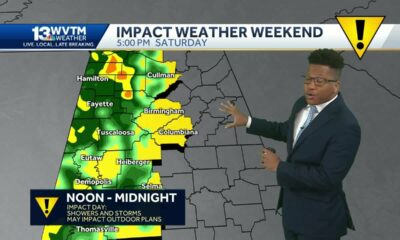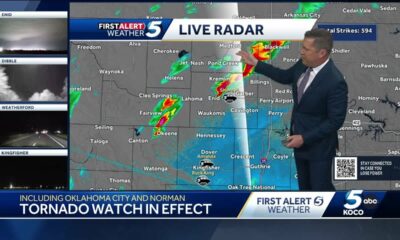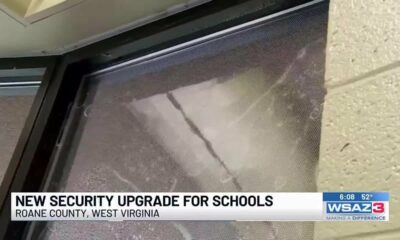News from the South - North Carolina News Feed
Concerns about lead in the water? Surprising ability to treat high-turbidity water? What are the plans to prevent another outage? And more… • Asheville Watchdog
Even though the City of Asheville is once again delivering potable water after Tropical Storm Helene devastated the water system Sept. 27, serious questions about the water’s safety, and the future of the water system remain.
Readers have sent dozens of questions to Asheville Watchdog, so we’ve compiled a roundup of them here, with answers from city officials. The Nov. 14 announcement that the city found detectable lead in seven schools is of particular concern, so we’ll start there.

Question: Readers have had multiple questions about the city’s announcement Nov. 14 that lead had been detected in seven schools — four in Buncombe County Schools, two in Asheville City Schools, and in one charter school. With 60 percent of Buncombe County’s housing stock dating to before 1988, when lead in pipes was banned, residents want to know: Is my water free of lead? If not, how much of a problem does it pose? And what should we do to protect ourselves?
Answer: The lead was detected after Asheville Water Resources suspended a standard treatment for lead mitigation for nearly three weeks because the city’s main reservoir’s sedimentation was so high and it has to use a bypass line to get water out. In all, water coming out of North Fork had no corrosion control chemicals in it for 19 days, with the program resuming on Oct. 30.
Corrosion control prevents lead from leaching into pipes and into tap water. The lead comes from solder used in older homes and buildings — those built in 1988 or before. It can leach into water systems when corrosion in pipes occurs, including from chlorine treatment, which is standard in municipal systems to kill contaminants.
The city has stated repeatedly that its testing has found no lead in the North Fork reservoir, Mills River treatment plant, or its distribution lines.
The city normally treats for lead prevention with zinc orthophosphate and sodium bicarbonate, minerals that coat the insides of pipes. The zinc material absorbs the lead, keeping it from reacting with the water, while the bicarbonate stabilizes the pH to slow corrosion.
Remember to flush
City officials have stressed that with proper flushing, lead leaves the pipes quickly. Assistant City Manager Ben Woody said at the Tuesday daily Helene briefing that the city initially tested 25 schools, childcare facilities and a residence, with lead detected at seven schools.
Woody said the city flushed the pipes at the seven schools for 30 seconds, and afterward six of them had no detectable lead levels, illustrating the importance of flushing pipes. One school, in South Asheville and on the Mills River water system, never lost corrosion control but still had detectable lead in water because the water had sat in pipes for so long.

“If you have water that sits in your pipes for more than four to six hours, and you live in a home built before 1988, you should be doing this (flushing) in any event,” Woody said.
The city has had a lead awareness program in place for several years.
“We’ve always said to flush your cold water lines for 30 seconds to two minutes (before) use, if the water has been setting for more than four hours,” Brenna Cook, the compliance officer for Asheville Water Resources, said at the briefing. “And this is if you’re using it for consumption. It is safe to wash your dishes, take a shower, wash your clothes in. There’s little possibility of lead exposure from those types of usage.”
You should always use cold water for cooking. Let the tap run until the water temperature changes, typically becoming slightly cooler.
Residents of homes built in 1988 or before should continue this flushing technique, as corrosion control can take 30 to 90 days to re-establish itself, Woody said. Corrosion control treatment was reestablished on Oct. 30.
Boiling does not remove lead
The city had a “boil water notice” in place until Nov. 18, and it recommended that residents use bottled water for consumption. But it also has said throughout the outage that if residents had no other option for potable water, they could boil water for at least a minute before consumption.
The Centers for Disease Control & Prevention notes that boiling water that may have lead in it will not reduce the amount of lead. Lead can cause development problems in children and is a well-known health hazard, and the CDC says there is no safe level of lead in water for children.
While the risk of exposure here was low, residents in older homes may have had exposure during the 19 days when treatment was suspended — if they were using boiled tap water for consumption.
“We are being inundated with lead test kit requests,” Cook said. “The people who need to be most concerned are people who are breastfeeding or pregnant, or people who have children in the home (under age 6), and especially homes built 1988 or before.”
Woody said the city will do another round of testing at schools at 30, 60 and 90 days. The city cannot run in-house lead testing.
“We do contract that out, and the lab that is doing that, it takes four to six weeks to get those results back,” Cook said.
You can request a lead testing kit here.
The city’s overall testing results can be found on the city’s Water Resources “Helene Response and Recovery” page, under “Post-Helene Lead and Copper Sampling Plan and Results.”
Why wasn’t lead issue disclosed earlier?
Asked why the city didn’t disclose the potential for lead exposure sooner, Woody said the city did not make an announcement about the lead until it had test results back. Initial results came in Nov. 4 and final results Nov. 8.
“Once we received detectable levels of lead through our sampling that we did at schools is when we made the decision to notify the community of the potential risk to lead exposure through their plumbing,” Woody said in an interview after Tuesday’s briefing.
Woody said plumbing varies from household to household, and “it’s just very difficult to say with certainty what 19 days of reduced corrosion control would do to anybody’s plumbing or house, because there are so many variables.”
At the briefing, Woody echoed the recommendation of the Buncombe County Health & Human Services department last week.
“If you have children under the age of six, or if you’re pregnant or nursing and you have concerns, please contact environmental health or talk to your pediatrician if you have concerns,” he said.

Question: What permanent changes or additions might be made at North Fork Reservoir to harden the facility or prevent another sustained outage? Will the city consider another bypass line in a different area? A heavier duty or totally different filtration system for higher turbidity? Does the city have a sort of “wish list” of needs moving forward that it would like to see addressed to prevent this in the future?
Answer: Woody said at the briefing the city has already begun an “after-action report” on the 54-day outage. The Sept. 27 storm washed out the two main distribution lines and a bypass line coming out of North Fork, which provides 80 percent of the city’s drinking water.
“A couple of things I can highlight right now is, yes, we are going to explore a primary water main that routes in a different direction,” Woody said. “We recognize that a key part of redundancy would be to have a water main from North Fork, number one, that doesn’t go underneath the spillway areas. And number two, as much as practical, avoids Swannanoa River Road.”
That would be expensive, Woody acknowledged, but he said it’s “absolutely something we’re going to look at and begin to initially move forward.” The city wants to ensure that water leaving North Fork is less vulnerable to storm-related damage.

Another action item is to proceed with “a permanent filtration improvement to North Fork so we don’t have to use the curtain anymore,” Woody said, referring to a curtain system the city installed in the reservoir to help still the water and promote coagulation of sediment. The storm caused severe sedimentation at North Fork that prevented water treatment for weeks.
“Another thing we’re going to explore — and this is already in our capital improvements plan — we want to make improvements to Mills River and increase the capacity and ability for that water treatment plant to provide water to the system,” Woody said. “So we want to increase our production outside of North Fork.”
North Fork typically produces about 21.5 million gallons of water a day, while the Mills River facility has been pumping out about 3 million gallons daily.

Question: It seems that the city water went from unsafe to drink and constant boil water notices to, “The water is fine to drink and perfectly safe.” How do we know it’s safe to drink? And how did the change occur so quickly?
Answer: In short, the city has been testing the water. A lot.
Woody said the city has performed over 1,000 water quality tests.
“We just did 120 last weekend,” Woody said Tuesday. “All those tests came back consistent with what our regulators require for us to deliver potable water to the community.”
That means no E. coli contamination or other harmful bacteria, and the outgoing level of turbidity is once again very low and under EPA parameters.
Woody noted that the return to potable water has been gradual. For several weeks, Asheville Water Resources has been adding treated water to the raw water coming out of the city’s main reservoir, North Fork.
“I think for a period of time now, we’ve been putting only potable water into the system, so we feel confident about the return of that treated water into our distribution system,” Woody said. “It’s just like it was pre-Helene.”
Essentially, the city had to push out all the untreated water from the city and replace it with treated water. That process is complete, and North Fork is once again producing enough water, in combination with the city’s Mills River treatment plant in northern Henderson County, to keep the system running under full pressure.

Question: Along the same lines, there’s confusion on how we went from needing a turbidity measurement of 1.5 to 2.0 Nephelometric Turbidity Units (NTUs) to be able to treat North Fork water to being able to treat much higher NTU water. On Monday, that number stood at 14.5 and it was even higher last week. Previously, Water Department spokesperson Clay Chandler said this hinged on the U.S. Army Corps of Engineers being able to employ a kind of portable system that allowed the city to run tests on higher-turbidity water. Can you explain how that process worked?
Answer: “There was a lot of uncertainty following this storm,” Woody said. “It was catastrophic in nature. It turned over our reservoir in a way that we’ve never seen before.”
So they had to approach water restoration in a way they’d never done before. The two primary transmission lines coming out of North Fork, as well as a backup line, were restored by mid-October.

But then the city had to deal with the extremely turbid North Fork reservoir, which had an initial NTU level of 79. One of the first moves the city made was to procure a pilot plant.
“That’s basically a test plant — it’s like a miniature representation of North Fork,” Woody said. “And what that allowed us to do is to begin testing the North Fork filter system to see if we, in fact, could place water into that plant that was of a greater turbidity than we thought otherwise we could do.”
Chemicals and curtains
The city also has conducted three in-reservoir treatment applications of aluminum sulfate, a coagulant, and caustic soda, which regulates the water’s pH levels to ensure optimum coagulation and sinking of clay particles. Additionally, the city installed the curtain system around the intake to still the water, promoting more coagulation of clay materials.
While turbidity remains, the density of the material is better.
“In other words, I think the clay particles did coagulate,” Woody said. “My understanding is they are lighter in nature, and so what we’ve found is that we can put that higher turbidity water into the North Fork treatment system.”
“But what we’ve also found is we have to do backwashes more frequently,” Woody continued. “So again, the system’s not running as it normally would with lower turbidity levels, but we are able to run it and manage it in a way that allows us to put water in again.”
Usually, North Fork’s pre-treatment water is very pure, with a turbidity under 1.0.
Cook, the Water Resources compliance manager, said, “In the water world, there’s all different kinds of turbidity.”
“When the lake was first turned over, there was a lot of mud, plus the light clay particles,” Cook said. The treatments did help settle out the mud, leaving finer clay particles that the city could filter.
“It depends on the type of turbidity you have, based on what you can run through a filter,” Cook said. “With our system, it being direct (filtration), you want a lighter turbidity instead of a heavier turbidity, and you want to be able to settle that out before you run it through the filter and cause problems with your filter or cause filter breakthrough.”
Woody said the city is backwashing the filters more frequently than usual to remove the material, but filtration can continue.
He also noted that the Army Corps of Engineers is continuing with its plan to set up a mobile filtration system at North Fork that is designed to handle higher turbidity water.
“We also have a degree of confidence, because we know that the Army Corps of Engineers is creating a redundancy, and they are still on schedule to have that completed in late November or early December,” Woody said.
That led to this question at the briefing…

Question: Why go ahead with the Army Corps of Engineers project if the city can now filter North Fork lake water?
Answer: “The most important thing that system does is create redundancy for our municipal water supply,” Woody said. “As everybody knows, North Fork is really the workhorse of our water system. Weather is unpredictable. If we were to have another storm one week from now, three three months from now, one year from now — whatever it is — we want to make sure that system is in place. Because what it allows us to do is filter water, to filter out the sediment in a way that we can make sure that North Fork is always operational.”
In short, it’s a “critical redundancy for our ability to provide water to our customers, and it’s just absolutely critical that we continue to make progress on finishing that improvement,” Woody said.

Question: When can city of Asheville water customers expect to begin being charged for their water?
Answer: Woody noted that water is an “enterprise fund,” meaning it pays for itself. The city recognizes that customers did not have potable water from Sept. 27 through Nov. 17 and was not sending out bills. Also, some flushing remains to be done, especially for businesses such as restaurants looking to reopen.
“Right now, what we anticipate is that beginning in December, we will start making meter reads again,” Woody said. “We’ll have more detailed information about that in the coming days, but we certainly don’t expect to begin billing and reading meters before early December at this point.”

Question: Regarding the curtains at the North Fork, will those be a permanent fixture? If so, are they susceptible to freezing other weather-related events?
Answer: The city bought the curtains and “will use those until the turbidity gets to a level that we are comfortable enough that we can remove them,” Woody said. “They won’t stay in the reservoir always and forever. So eventually they will come out.”
The city does not have concerns about weather-related damage to the curtains, he said.
Asheville Watchdog is a nonprofit news team producing stories that matter to Asheville and Buncombe County. John Boyle has been covering Asheville and surrounding communities since the 20th century. You can reach him at (828) 337-0941, or via email at jboyle@avlwatchdog.org. The Watchdog’s local reporting during this crisis is made possible by donations from the community. To show your support for this vital public service go to avlwatchdog.org/support-our-publication/.
Related
The post Concerns about lead in the water? Surprising ability to treat high-turbidity water? What are the plans to prevent another outage? And more… • Asheville Watchdog appeared first on avlwatchdog.org
News from the South - North Carolina News Feed
Raleigh City Council discusses transforming area near Lenovo Center, hears concerns
SUMMARY: Raleigh City Council is considering a major redevelopment project near the Lenovo Center that would create a new sports and entertainment district with high-rise buildings, restaurants, shops, and upgraded arena facilities. The proposal, supported by city leaders and the Carolina Hurricanes—who agreed to stay for 20 more years—has drawn both excitement and concerns. Students and staff from nearby Cardinal Gibbons High School support the project but worry about pedestrian safety and construction impacts. City leaders suggested annual reviews to address ongoing issues. The council postponed rezoning decisions until April 15 to allow for more discussion and public input.

New details are emerging about the bold new development that could transform the area around Raleigh’s Lenovo Center, creating a new entertainment district around the arena in west Raleigh.
More: https://abc11.com/post/raleigh-city-council-will-discuss-future-including-wake-bus-rapid-transit-project-housing-security/16114907/
Download: https://abc11.com/apps/
Like us on Facebook: https://www.facebook.com/ABC11/
Threads: https://www.threads.net/@abc11_wtvd
X: https://x.com/ABC11_WTVD
Instagram: https://www.instagram.com/abc11_wtvd/
TIKTOK: https://www.tiktok.com/@abc11_eyewitnessnews
Subscribe: https://www.youtube.com/c/ABC11-WTVD
News from the South - North Carolina News Feed
Asheville has North Carolina’s worst unemployment rate, state says
Six months later and still out of a job. That’s the reality for nearly 13,000 Asheville residents half a year after Tropical Storm Helene struck Western North Carolina.
In the wake of the historic storm, hundreds of businesses closed. The region’s multibillion dollar tourism sector took a devastating hit. Thousands of people were severed from their jobs. Many have not returned to the workforce.
Asheville, a city of roughly 95,000 people, typically boasts the lowest unemployment rate of North Carolina’s municipalities.
[Subscribe for FREE to Carolina Public Press’ alerts and weekend roundup newsletters]
But not now. Not after Helene.
As of January, the most recent figures available, Asheville had a 6% unemployment rate — the state’s highest — according to the N.C. Department of Commerce.
Clark Duncan, director of the Asheville Chamber of Commerce, calls the ranking a “new and unwelcome accolade.”
Help wanted in Asheville
Rocky Mount and Fayetteville, each hovering around 5% unemployment, are giving Asheville a run for its money.
The capital city of Raleigh is home to North Carolina’s lowest jobless rate at 3.2%.
And statewide, that number is a respectable 4%.
But Asheville’s high rate of unemployment doesn’t necessarily mean there aren’t jobs in the region, according to one expert.
“Buncombe County certainly does not have a jobs problem,” said Andrew Berger-Gross, a senior economist for the N.C. Department of Commerce. “What they have is an unemployment problem. We see employers hiring, but there is a large contingent of workers who have not returned to work.”
First, there is what economists call a “matching problem.” Meaning, the jobs that need to be filled do not match the skills and interests of the unemployed.
There are 20,000 job openings in the region, according to Nathan Ramsey, director of the Mountain Area Workforce Development Board. Sectors like health care and manufacturing are on track for normal hiring numbers. Plus, Helene actually created jobs in certain industries, such as construction and debris removal.
“You may be the best bartender in the world, the best server, the best cook — but does that mean you want to drive an 18-wheeler up mountain roads?,” Ramsey asked. “Does that mean you can do — or want to do — construction? Probably not.”

Second: Just because someone needs a job doesn’t mean they are ready or able to get one.
“It is safe to assume that a lot of those unemployed workers might be facing barriers to re-employment — like losing your home or losing your car,” Berger-Gross explained. “Frankly, some people might still be struggling with the emotional trauma of the hurricane’s destruction.
“A lot of these people may need help putting their lives back together before they are ready to return to the workforce.”
Though unemployment rates rose in Asheville and Buncombe County in winter months, the amount of open positions in the region is a positive sign for an economic rebound, as are increased retail sales and hotel occupancy.
But there are concerns that the state’s disaster unemployment program might not be working as it should.
“I get a lot of emails from folks who are kind of struggling with getting unemployment assistance,” state Sen. Julie Mayfield, D-Buncombe, told Carolina Public Press. “Either they’ve applied for it and they haven’t gotten it or they’ve been turned down because they’re back at work a little bit, but not full time.”
Mayfield is hopeful that tourists will arrive to watch wildflowers bloom across the Appalachians this spring.
But wildfires across Western North Carolina may jeopardize those plans.
Smoke signals
Closed trails and roads, mandatory evacuations and poor air quality have scared off springtime tourists and kept locals from their typical routines.
Adventure tourism businesses in the area aren’t operating, putting tour guides and other personnel out of work, said Brevard Mayor Maureen Copelof. Evacuation orders in her county were lifted early this week, but Brevard’s annual bike race — Assault on the Carolinas — was canceled due to the fires.
While most economic indicators in Western North Carolina have been trending positive, an additional natural disaster, such as these fires, threatens to stall recovery before the region can fully rebound.
There is an emotional impact of the wildfires as well. The din of helicopters above the mountains is a painful reminder of the panic and trauma of Helene. Plus, the downed trees and mangled forest floors from the storm make the blazes worse.
“Some people were really triggered by the fact that there was another threat to their home and their health on the six-month anniversary of Helene,” said Leah Matthews, a UNC-Asheville economics professor. “You have people thinking: ‘I’m just starting to rebuild this house and now I need to evacuate again.’”
In the wake of wildfire and flood, economic recovery in the mountains will require patience and a willingness to adapt. The community is wrestling with fundamental questions about its identity and future.
“The elephant in the room is that the region suffered a historic tragedy, and you can’t push rewind on the VCR of life,” Berger-Gross said. “You can’t go back to a time before the disaster hit — that is why it is a tragedy. All of us are trying to move to a better future for Asheville and for Western North Carolina more broadly. But will things be exactly like they were before the hurricane? No, they can’t be.”
This article first appeared on Carolina Public Press and is republished here under a Creative Commons Attribution-NoDerivatives 4.0 International License.![]()
The post Asheville has North Carolina’s worst unemployment rate, state says appeared first on carolinapublicpress.org
News from the South - North Carolina News Feed
Fixing the DMV: Latest on commissioner search, technology upgrades
SUMMARY: In response to significant issues such as long wait times and appointment shortages, North Carolina’s DMV is seeking improvements by partnering with Arizona, which ranks fourth nationally for DMV efficiency. Governor Josh Stein and Transportation Secretary Joey Hopkins highlighted ongoing leadership changes, including the search for a new commissioner after Wayne Goodwin’s departure. Current challenges stem from staffing shortages and outdated technology. Governor Stein’s proposed budget includes funding for over 100 new positions to alleviate these issues. The state plans to adopt Arizona’s software to enhance service efficiency and customer satisfaction, with leadership decisions expected in the coming weeks.

North Carolina is partnering with Arizona to improve its struggling Division of Motor Vehicles, aiming to reduce long wait times and make more appointments available.
-

 News from the South - Florida News Feed7 days ago
News from the South - Florida News Feed7 days agoFamily mourns death of 10-year-old Xavier Williams
-

 News from the South - Alabama News Feed6 days ago
News from the South - Alabama News Feed6 days agoSevere storms will impact Alabama this weekend. Damaging winds, hail, and a tornado threat are al…
-

 News from the South - Alabama News Feed5 days ago
News from the South - Alabama News Feed5 days agoUniversity of Alabama student detained by ICE moved to Louisiana
-

 News from the South - Louisiana News Feed7 days ago
News from the South - Louisiana News Feed7 days agoSeafood testers find Shreveport restaurants deceiving customers with foreign shrimp
-

 News from the South - Oklahoma News Feed4 days ago
News from the South - Oklahoma News Feed4 days agoTornado watch, severe thunderstorm warnings issued for Oklahoma
-

 Mississippi Today15 hours ago
Mississippi Today15 hours agoPharmacy benefit manager reform likely dead
-

 News from the South - West Virginia News Feed7 days ago
News from the South - West Virginia News Feed7 days agoRoane County Schools installing security film on windows to protect students
-

 News from the South - Virginia News Feed5 days ago
News from the South - Virginia News Feed5 days agoYoungkin removes Ellis, appoints Cuccinelli to UVa board | Virginia












































